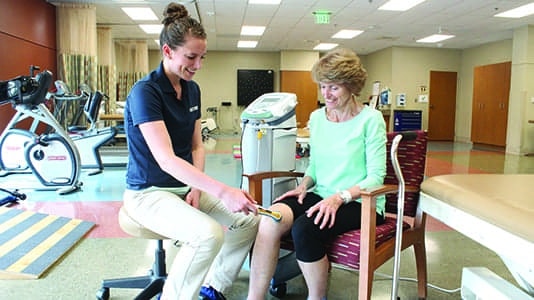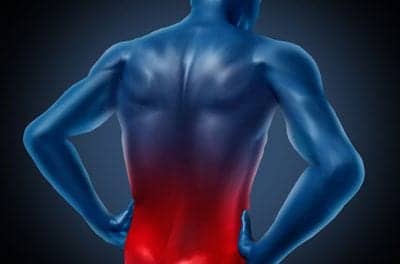
Rachel Russo, PT, DPT, administers low level laser treatment during a rehab session. The device calculates dosage automatically based on indications to target localized pain and edema.
by Vidhya Kannan, DPT Therapists play a vital role in the modulation of pain at peripheral, spinal, and CNS levels through an eclectic approach which utilizes physical agents along with other treatment strategies. The key to treating pain is to understand the underlying cause(s) and carefully select the treatment options inclusive of pain relief tools to optimize outcomes.
Perspective on Pain Management
The perception of pain, although subjective in nature, is an important indicator to assess the success of treatment strategies. The quest for pain management dates to ancient history, as such primitive pain relief treatments are documented globally. History reveals that Hippocrates used willow bark and leaves for pain management. Willow trees, classified under plant genus Salix, contain salicylic acid, which is an active ingredient in aspirin.1 Recent forms of conservative pain relief treatments are a result of this century-old quest. Clinicians often study pain and focus on the classificatory component of pain—eg, nociceptive, inflammatory, pathological, neuropathic, etc—and it is imperative that strategies also address the emotional and cognitive aspects of pain to ensure success. The goal of many modalities is to modulate pain through mechanisms that alter the physiologic response which can provide the patient some sense of control over the pain. While formulating a plan of care for pain relief, the inclusion of carefully chosen physical agents often can assist the clinician to quickly gain the patient’s trust, which also addresses the cognitive aspect. This can help the clinicians manage pain more autonomously versus solely relying on physicians for providing pain relief. Electro-modalities are widely used in outpatient settings, but are generally underutilized in acute care, acute rehabilitation, and home health environments. There may be several contributing factors to this observation. However, the most common reason I have observed is the clinicians’ limited comfort level with the modalities or limited exposure to supporting evidence. Clinicians seeking clinical knowledge through evidence-based practice should analyze and consider any possible flaws in the research methods to validate the results. For example, a study discussing the efficacy of administration of ultrasound for pain relief, completed without controlling the effective radiation area (ERA), can produce invalid results. The time invested in learning how the modalities work positions the clinician to analyze research thoroughly while applying their knowledge to make sound clinical decisions. The proposal to consider evidence-informed practice instead of evidence-based practice is very valuable in clinical practice. Evidence-informed practice emphasizes clinical decision-making inclusive of patient preferences/motivation and clinical experience/judgement of the practitioner.2 While managing a plethora of personal ankle and knee injuries sustained during martial arts practice with a conservative, non-pharmacological approach for years, I have become an enthusiastic advocate of including modalities in the plan of care, when appropriate. These injuries provided me the opportunity to assess and manage modality efficacy without consuming analgesics to restore mobility. Self-administration of modalities helped me understand what the patients feel during the treatment. This unique perspective influenced my clinical practice. I was pleasantly surprised with the quick turnaround time from the administration of the modalities and the pain relief I experienced. I would like to emphasize that although it is not a “one size fits all” solution for all types of pain, I believe that an eclectic approach can increase the chances of managing certain types of pain efficiently. Several modalities are portable and can be purchased for home use, making pain management easily accessible and effective.
Making Modalities Work
Under normal circumstances, the nociceptive sensory system returns to a normal functional state as soon as healing takes place.3(p1) However, at times the normal circumstances are challenged by persistent inflammation caused by various stimuli, including repetitive movements. During such instances, promoting recovery of tissues through stabilization (taping, immobilization, etc) of the area to minimize repetitive stress and manage pain becomes the priority to restore function. Unlike most analgesic drugs that are distributed throughout the body, modalities can be very effective in addressing local inflammation and edema, as well as providing pain relief while targeting the involved tissues directly without the unnecessary distribution. Most electro-modalities work based on pain gate theory. Pain gate theory was first proposed by Ronald Melzack and Patrick Wall in 1965. This theory suggests that for the sensation of pain to pass through the gate, there must be unopposed passage for nociceptive information arriving at the synapses of substantia gelatinosa.4 Subsequently, if the gate is also concurrently receiving impulses produced by stimulation of thermoreceptors or mechanoreceptors (transmitted through large diameter myelinated fibers), then this traffic predominates, inhibiting the nociceptive impulse carried by small diameter fibers.4,5 Many electrical agents stimulate nerve endings connected to large-diameter afferent nerves and thus override the A delta and C fibers that carry the nociceptive information.6
Brief Overview of Modalities
Conventional TENS (Transcutaneous Electrical Nerve Stimulation) closes the pain gate through large-diameter afferent input and is effective in managing acute pain.6 Most common treatment parameters for this type of TENS: Frequency between 100 to 150 Hz, pulse width is between 100-500 microseconds.7 Low frequency TENS works by stimulating efferent pathways at the cerebral level, which is widely used for chronic pain management. This works by providing a nociceptive stimulus which is carried to the cerebrum through the interaction of the periaqueductal gray matter and raphe nucleus, which causes the release of opiate-like substances at the cord level.7(p102) The burst-type TENS can produce a noxious stimuli and possible muscle twitch, making it less desirable and uncomfortable.8 Most common treatment parameters: Frequency 1 to 5 Hz and pulse width 100 to 150 microseconds. Interferential current is designed to cross two medium-frequency currents to produce a low-frequency current effect,7 and is generally used for providing analgesic effect over a larger treatment area. Because the skin impedance is inversely proportional to the frequency of the current, medium frequency currents are utilized to overcome the skin impedance for targeting deeper tissues without unnecessary skin stimulation, making it more tolerable for the patients.7 This can be used to treat a larger treatment area, and the depth of the stimulation can be controlled by appropriately spacing the electrodes. Therapeutic ultrasound uses ultrasonic waves that are administered through the tissues, and the sound energy is converted to heat after being absorbed by the tissues. The extensibility of the collagen is increased by the rise in tissue temperature, which favors stretching of scars and adhesions. Ultrasound increases the permeability of the cell membranes through a phenomenon called stable cavitation.7 Ultrasound can also be used during all three stages of tissue repair: inflammatory, proliferative, and remodeling stages. The mechanical effects of the ultrasound help remove the traumatic exudate and reduce the danger of adhesion formation, which is crucial in recovery.7(p174) Cold packs can induce local vasoconstriction followed by vasodilatation, and can be utilized effectively when the treatment is timed according to the required physiological effects (“hunting reaction”) it produces. The probable mechanism involved during pain relief is the stimulation of thermoreceptors which pass through large-diameter nerves.9 Cold sensation being noxious in nature is also believed to stimulate areas of the mid-brain to produce beta endorphins and encephalin in the posterior horn, which subsequently causes temporary pain relief.10 Topical analgesics are a common type of pain reliever that can be used in the clinic or for patients to apply at home. Active ingredients often found in these products are menthol and capsaicin. Topical analgesics can be used to provide temporary relief for a variety of symptoms such as low back pain, musculoskeletal strains, and pain symptoms associated with osteoarthritis. A wide range of these products is available in the form of gels, creams, or sprays. Low intensity laser therapy (LILT) is widely used to target a localized area of inflammation, making it a valuable tool to treat tendinitis, acute pain, edema, and muscle spasm over a smaller treatment area. LILT has become easier to use than ever before, as most laser-emitting systems come with an automated dose calculator and an indications guide to assist clinicians to choose the most specific treatment parameters to attain desirable effects.
Manual In the Mix
When pain is caused by nociceptive stimuli arising from faulty or restrictive arthro-kinematics, manual therapy is one of the most effective sources of treatment to promote alignment of structures. Modalities such as thermal ultrasound and TENS used in conjunction with manual therapy can make the treatment more effective and tolerable. Modalities can be used preceding manual therapy treatment to prepare tissues for potential stretch by increasing local circulation to prevent excessive tissue damage and irritation with induced stretch. The increased tissue temperature from thermal ultrasound favors the remodeling of the restricted collagen during stretching, joint mobilization, and scar mobilization techniques. TENS can be used for acute pain relief in the burst mode while manipulating or mobilizing joints through painful range.
From Experience Comes Wisdom
With the advancement of pain management treatment approaching, most clinicians agree that there is a tectonic shift in the emphasis for identifying the source of pain before treating pain. In my experience working with a wide range of surgeons and specialists, I have observed that most of their focus on pain management is from their perspective of the source of the pain relating to their expertise. While most surgeons focus on the mechanical source of pain and pain management specialists focus on altering the physiology through multimodal drugs or invasive procedures, therapists have a unique role in delivering effective strategies, as their knowledge base is more profound to interactive systems and thus are positioned well to successfully manage pain through a conservative approach with limited-to-no side effects. Physical therapists possess a distinctive knowledge of human system interactions, and of how different techniques and agents promote recovery and healing. This knowledge plays an unquestionable part in effective pain management. With more knowledge comes more power in making a difference in healthcare; ignorance is not bliss. RM Vidhya Kannan, DPT, is the director of therapy operations at HealthSouth Rehabilitation Hospital of Northern Virginia. Prior to joining HealthSouth, Vidhya treated outpatients and has worked as a traveling therapist, enabling her to treat individuals with varied diagnosis while emphasizing pain management in different healthcare settings. Kannan’s experience working alongside pain management specialists, orthopedic surgeons, spine surgeons, physiatrists, psychologists, and multidisciplinary teams offers her a unique perspective and enables her to tap into a wide array of sources to treat pain. Kannan’s background includes a doctorate in physical therapy from Shenandoah University and more than 15 years of experience as a physical therapist. In addition, she has undergone Accelerate Care Plus training for utilizing electro-modalities and has a diploma in acupuncture. For more information, contact [email protected].
Light Therapy Requires Laser Focus on Dosimetry to Create Photobiomodulation
By Mark Callanen, PT, DPT, OCS There is a vast body of research that has been growing since the 1960s showing the efficacy of light to promote healing. In current literature this technology is referred to as photobiomodulation (PBM).1 PBM is the most accurate description of how laser therapy effects tissue. Damaged tissue is normally associated with being under oxidative stress due to down regulation of the electron transport chain.2 Laser delivers photons that excite Cytochrome C Oxidase located in the inner mitochondrial membrane. This causes increased ATP production in damaged cells while stimulating a number of anti-inflammatory and tissue regenerating pathways.3,4 PBM can be introduced by various light sources. Laser is an excellent tool for PBM as it is monochromatic (utilizes a single wavelength) and has a columnar, coherent beam that sends light in one direction in an organized fashion. These characteristics allow it to be fine-tuned for specific applications. There are a variety of lasers that can promote PBM. Lasers are classified by the power that they produce and range from Class II (1 mW) to Class IV (> 500 mW). Traditionally, the term LLLT or Low Level Light Therapy has been applied to Class II and III lasers as well as LED light sources as they do not create any heat at the skin. Regardless of the power of the light source that is being used, the applied wavelength significantly impacts human tissue as different wavelengths are absorbed preferentially by different molecules at various depths in the body.5 Once the ideal wavelengths have been selected, the next significant variable influencing light’s effectiveness in creating PBM is dosimetry. Having insufficient amounts of light at the level of the target tissue will have little to no therapeutic effect,6 while overexposure can actually inhibit the healing process.7 PBM is maximized when the appropriate amount of photonic energy (for a given wavelength) is applied. To achieve desired dosages of light energy to tissue, usually defined in J/ cm2, there are three key variables that will impact it; power, time, and the treatment area. Dosimetry is significantly impacted when these values change. The class and power of the laser will influence the degree you can alter power. There are many other factors that influence PBM, but understanding dosimetry and how the physics of energy impacts its effectiveness is a good start when attempting to incorporate laser therapy into a plan of care.
References
1. Norn S, Permin H, Kruse PR, Kruse E, et al. From willow bark to acetylsalicylic acid [Article in Danish]. Pain Med. 2009 Mar; 10(2):289-99. doi: 10.1111/j.1526-4637.2008.00558. 2. Guccione A, Wong R, Avers D. Geriatric Physical Therapy. Syracuse, NY: Elsevier Mosby; 2011. 3. University of Wisconsin School of medicine and public health. Pain management pathophysiology and clinical implications. http://projects.hsl.wisc.edu/GME/PainManagement/session2.4.html. Published 2010. Accessed June 2017. 4. Melzack R, Patrick W. Gate control theory of pain. Pain. 1968:11-31. 5. Hems J, Barone C. Physiology and treatment of pain. Critical Care Nurse. 2008;28(6):38-49. http://ccn.aacnjournals.org/content/28/6/38.full 6. Frampton V. Pain control with the aid of transcutaneous nerve stimulation. Physiotherapy. 1982;68(3):77-81 7. Forster A, Palastanga N. Clayton’s electro therapy theory and practice. Philadelphia, PA; 1996 8. Barr J, Weissenbuehler S, Cleary C. Effectiveness and comfort of Transcutaneous electrical nerve stimulation for older persons with chronic pain. J Geriatr Phys Ther. 2004;27(3):93-99. 9. Golf B. Excitatory cold. Physiotherapy. 1969;55(11):467. 10. Lee J, Warren M. Ice relaxation and exercise in reduction of muscle spasticity. Physiotherapy. 1974;60(10):296.




